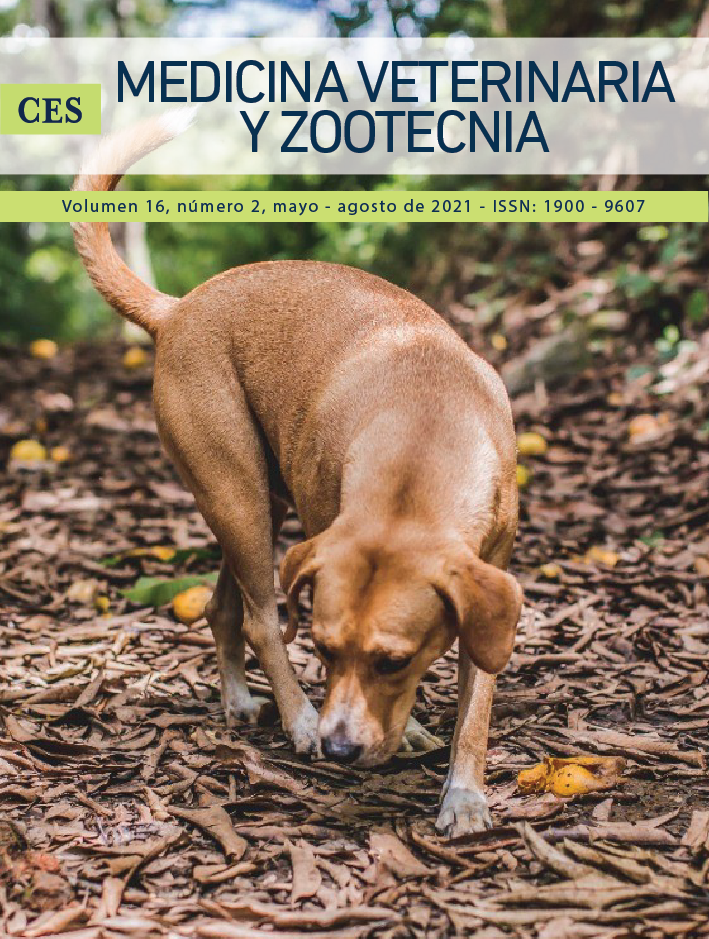The Environmental fate and ecological effects of the three most commonly used herbicides in Colombia
DOI:
https://doi.org/10.21615/cesmvz.6238Keywords:
amphibians, Colombia, glufosinate, glyphosate, herbicides, propanilAbstract
Knowledge of the environmental and transport fate of pesticides is integral to characterizing environmental exposures. Agencies such as the Environmental Protection Agency (EPA) (27) integrate the characterization of an exposure with ecological effects to determine the risks of pesticide use. The three most widely used herbicides in Colombia are glyphosate, propanil, and glufosinate ammonium. Although glyphosate had, since the early 1970’s, been considered an environmentally friendly herbicide, the weight of the evidence of studies beginning in the 1990s show that inadvertent applications in wetlands can be fatal to the larvae of amphibians. Although glyphosate formulations are typically considered moderately toxic (LC50 = 1-10 ppm) for most aquatic organisms, for many amphibian species they are highly toxic (LC50 ˂ 1 ppm). This concern is compounded by the fact that Colombia has an incredibly high diversity of amphibians (746 species). In addition, chronic exposures of some amphibian species to sublethal concentrations, which are more likely found in the environment, have been shown to cause decreased survival, intersex gonads, tail damage, prolongation of time to metamorphosis, and liver lipidosis. In Colombia, aerial applications of Glyphos-Cosmo-Flux have been used since 1997 to fumigate illicit coca crops. As of 2019, the International Union for Conservation of Nature (IUCN) Red List had 285 species of amphibians in Colombia considered threatened. We found that 132 of the endangered (EN) and critically endangered (CR) amphibian species were present in 11 of the 32 Colombian departments with illegal coca plantations. Therefore, studies are needed to evaluate the impact of the coca eradication program on the amphibian population of the country. Propanil is the main herbicide used in rice fields. Despite its rapid environmental degradation (1 day in aerobic conditions), studies on the impact of propanil have found that at projected application rates (4.5 kg/ha), within 48 hours after application, it reduces dissolved oxygen to levels critically important for survival of fish. At very low concentrations of 50 ppb or less of propanil, this effect correlates with lower phytoplankton production rather than higher community respiration. Despite being mild to moderately toxic at acute exposures, chronic exposure data also show that concentrations greater than 9 ppb affect the growth, reproduction, and development of fish and invertebrates. With respect to glufosinate ammonium, although it is highly likely to contaminate surface (runoff) and groundwater due to its physicochemical properties, data suggest that it is practically non-toxic to aquatic and terrestrial species. The acute hazard ratios were well below the level of concern, and therefore the EPA determined that the acute risk to non-target terrestrial and aquatic organisms is very low.
Downloads
References
Bernal MH, Solomon KR, Carrasquilla G. Toxicity of formulated glyphosate (Glyphos) and cosmo-flux to larval colombian frogs. Laboratory acute toxicity. J. Toxicol. Environ. Health 2009a; 72:961-965.
Bernal MH, Solomon KR, Carrasquilla G. Toxicity of formulated glyphosate (Glyphos) and Cosmo-flux to larval and juvenile Colombian frogs 2. Field and Laboratory microcosm acute toxicity. J. Toxicol. Environ. Health 2009b; 72:966-973.
Cuervo JL, Fuentes CL. Mineralization and sorption of 14 C-glyphosate in samples from three soil types collected in El Espinal, Colombia. Rev. Acad. Colomb. Cienc 2014; 38(148):287-297.
Department of State of U.S.A. International Narcotics Control Strategy Report Volume I Drug and Chemical Control March 2021; disponible en: https://www.state.gov/2021-incsr-volume-i-drug-and-chemical-control-as-submitted-to-congress/. (Accessed: April 25, 2021).
Edginton AN, Sheridan PM, Stephenson GR, Thompson DG, Boermans HJ. Comparative effects of pH and Vision herbicide on two life stages of four anuran amphibian species. Environ. Toxicol. Chem. 2004; 23:815-822.
Folmar, L. C., Sanders, H. O., & Julin, A. M.Toxicity of the herbicide glyphosate and several of its formulations to fish and aquatic invertebrates. Archives of Environmental Contamination and Toxicology 1979; 8(3):269-278.
Fuentes L, Moore LJ, Rodgers JH, Bowerman WW. Comparative toxicity of two glyphosate formulations (original formulation of Roundup and Roundup Weathermax) to six North American larval anurans. Environ. Toxicol. Chemistry 2011; 30(12):2756-2761.
Giesy JP, Dobson S, Solomon KR. Ecotoxicological risk assessment for Roundup herbicide. Rev. Environ. Contam. Toxicol. 2011; 167:35-120.
Glenn, C. R. Endangered Creatures & quot. 2006 (Online). Accessed 4/26/2021 at http://earthsendangered.com.
Howe CM, Berrill M, Pauli BD, Helbing CC, Werry K, Veldhoen N. Toxicity of glyphosate-based pesticides to four North American frog species. Environ. Toxicol. Chemistry 2004; 23(8):1928-1938.
Instituto Colombiano Agropecuario. Boletín de Estadísticas de comercialización de Plaguicidas – 2019 https://www.ica.gov.co/getdoc/1908eb2c-254f-44de-8e21-c322cc2a7e91/estadisticas.aspx
Llorente M.V and Garzon J.C. ¿Por qué siguen aumentando los cultivos de coca en Colombia? Fundación Ideas para la Paz (FLIP). 2018. Disponible http://www.ideaspaz.org/publications/posts/1686 (Accessed: April 25, 2021).
Lynch JD, Arroyo SB. Risk to Colombian amphibian fauna from cultivation of coca Erythroxylum coca): A Geographical analysis. J. Toxicol. Environ. Health 2009; Part A, 72:974-985.
Mann RM; Bidwell JR, Tyler MJ. Toxicity of herbicide formulations to frogs and the implications for product registration: A case study from Western Australia. Applied Herpetology 2003; 1:13-22.
Mitchell DG, Chapman PM, Long TJ. Acute toxicity of RoundupR and RodeoR herbicides to rainbow trout, Chinook and Coho salmo. Bull. Environ. Contam. Toxicol. 1987; 39:1028-1035.
Moore H, Chivers DP, Ferrari MCO. Sub-lethal effects of RoundupTM on tadpole anti-predator responses. Ecotoxicol. Environ. Safety 2015; 111:281- 285.
National Pesticide Information Center (NPIC). Available at http://npic.orst.edu/HPT/ (Accessed October 2021).
Observatorio de Drogas de Colombia. Ministerio de Justicia. http://www.odc.gov.co/sidco/oferta/cultivos-ilicitos/departamento-municipio (Accessed in October 2021)
Perschbacher PW, Stone N, Ludwig GM, Guy Jr. CB. Evaluation of effects of common aerially-applied soybean herbicides and propanil on the plankton communities of aquaculture ponds. Aquaculture. 1995; 157:117-122.
Relyea RA. Amphibians are not ready for Roundup. J.E. Elliott et al. (eds.), Wildlife Ecotoxicology: Forensic Approaches, Emerging Topics in Ecotoxicology 2011; 3: 284-285.
Relyea RA. The lethal impact of Roundup on aquatic and terrestrial amphibians. Ecol. Appl. 2005; 15:1118-1124.
Riaño C, Ortiz-Ruiz M, Pinto-Sanchez NR, Gómez-Ramírez E. Effect of glyphosate (Roundup ActiveR) in liver of tadpoles of the colombian endemic frog Dendropsophus molitor (amphibia: Anura). Chemosphere 2020; 250:126287.
Roberts DM, Heilmair R, Buckley NA, Dawson AH, Fahim M, Eddleston M, and Eyer P. Clinical outcomes and kinetics of propanil following acute self-poisoning: a prospective case series. BMC Clinical Pharmacology. 2009; 9:3
Solomon KR, Marshall EJP, Carrasquilla G. Human health and environmental risk from the use of glyphosate formulations to control the production of coca in Colombia: overview and conclusions. J. Toxicol. Environ. Health 2009; A, 72:914-920.
Tucker CS. Short-term effects of propanil on oxygen production by plankton communities from catfish ponds. Bull. Environ. Contam. Toxicol. 1987; 39:245-250.
Union Internacional para la conservación de la naturaleza. Read List of threatened species. https://www.iucnredlist.org/ (Accessed October 2021)
U.S. Environmental Protection Agency (USEPA). Overview of the Ecological Risk Assessment Process in the Office of Pesticide Programs. Office of Prevention, Pesticides, and Toxic Substances. 2004; Office of Pesticide Programs. Washington, D.C.
U.S. Environmental Protection Agency. Problem formulation for the ecological risk and drinking water exposure assessments in support of the registration review of glyphosate and its salts. 2009; Office of Pesticide programs, Environmental fate and Effects Division. Washington, D.C.
U.S. Environmental Protection Agency. Reregistration Eligibility Decision for Propanil (N-(3,4-dichlorophenyl) propanamide). List A, Case 0226. 2003; Office of Pesticide Programs, Washington D.C.
U.S. Environmental Protection Agency. Environmental fate and ecological risk assessment for the registration of glufosinate-ammonium on canola, sugarbeets and potatoes. 1999; Office of Pesticide Program.
U.S. Fish and Wildlife Service. Recovery plan for the California Red-legged Frog (Rana aurora draytonii) 2002; U.S. Fish and Wildlife Service, Portland, Oregon. Viii + 173 pp.
Villarroel MJ, Sancho E, Ferrando MD, Andreu E. Acute, chronic and sublethal effects of the herbicide propanil on Daphnia magna. Chemosphere 2003; 53(8):857-64.
Downloads
Published
How to Cite
Issue
Section
License
Copyright (c) 2021 CES Medicina Veterinaria y Zootecnia

This work is licensed under a Creative Commons Attribution-NonCommercial-ShareAlike 4.0 International License.
| Article metrics | |
|---|---|
| Abstract views | |
| Galley vies | |
| PDF Views | |
| HTML views | |
| Other views | |



